Asian hornet in Europe
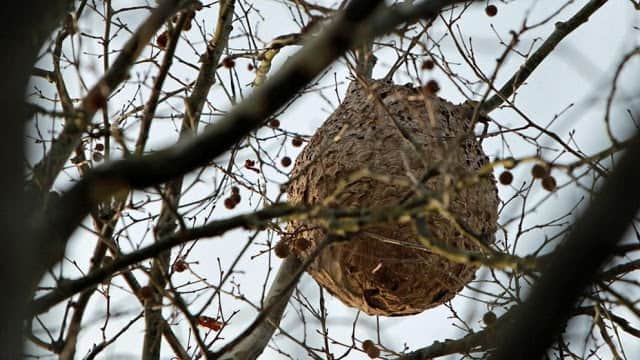
Asian hornets, formidable enemies of bees, appeared in Europe not so long ago, but have already managed to cause serious damage to beekeeping by exterminating hundreds of thousands of bee colonies, causing great losses to gardeners and farmers, and to the food security of the regions. What is the Asian hornet, how did it appear in Europe, where does the Asian hornet live in Europe, why is the Asian hornet dangerous, how to deal with the Asian hornet and much more, can the Asian hornet appear in Russia and much more. Read to the end - it will be interesting!
Content
- Asian hornet description
- Asian hornet nest
- How the Asian hornet appeared in Europe
- Asian hornet where it lives in Europe
- Why is the Asian hornet dangerous?
- Measures to combat the Asian hornet
- Asian hornet in Russia
Asian hornet description
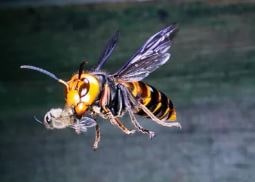
The Asian hornet, Latin name Vespa velutina, is slightly smaller than the European hornet (Vespa crabro). Typically, female Asian hornets are 30 mm long, and males are approximately 24 mm long. Working individuals are approximately 20 mm long. The Asian hornet has characteristic yellow legs. The chest is velvety brown or black with a brown belly. Each abdominal segment has a narrow posterior yellow border, with the exception of the fourth segment, which is orange. The head is black and the face is yellow. Regional forms vary quite a lot in color.
In September 2019, the Asian hornet was discovered in Canada on Vancouver Island. In December 2019, it was discovered in the USA, in Washington state.
The Asian hornet produces highly toxic poison, so the sting of this hornet is much more dangerous than the sting of the European hornet. The hornet produces a lot of poison. The sting of an Asian hornet is deadly for those who are allergic to bee and wasp venom; if stung by a large number of hornets, even a person who does not suffer from allergies can die.
For hunting, Asian hornets do not use a sting, but large jaws, with which they crush their prey. The Asian hornet can use its sting repeatedly, just like an ordinary wasp.
Asian hornet nest
Asian hornets live in large nests - up to 1 meter in length and 80 cm in diameter and up to 10 thousand individuals in one nest. And all these thousands return to the hives again and again, replacing each other every second, until they empty the entire hive. Asian hornets also hunt wild bees, both social and solitary. They are especially dangerous in the fall, when there are few insects in nature. The Asian hornet is very prolific and multiplies at a frantic pace, each nest - colony leaves 200 queens in the fall, which will create colonies themselves next year. The density of hornet nests is constantly growing; their huge nests can often be found in urban areas. Beekeepers from Asturias complain that if in 2015 they met 60 hornet nests a year, then in 2016 there were 300-400 nests, despite the fact that hornets entered Asturias only in 2014.
How the Asian hornet appeared in Europe
The Asian hornet has never lived in Europe, but in 2004, it was discovered in France in the vicinity of one of the ports. It is believed that the hornet sailed from China on a ship carrying pottery. This is how the Asian hornet began its march across Europe, occupying one area after another.
Asian hornet where it lives in Europe
Asian hornets, which arrived in France in 2004, are now recorded in large areas; they have occupied all of France and parts of Spain, Belgium, Germany, Italy and Portugal, occupied the Bolearic Islands, and have now appeared in the UK. The hornet was first spotted in the UK this summer on the Channel Islands of Jersey and Alderney. And then Asian hornets were discovered directly in England - in the county of Gloucestershire. Austrian beekeepers are also afraid of the Asian hornet entering the country. Italian beekeepers indicate that the Asian hornet entered Liguria in 2012, where in five years it reduced the number of bee colonies by half.
The hornet also penetrated into the provinces of Piedmont and Veneto; in 2017, the hornet was discovered in the province of Tuscany. In 2017, the Asian hornet entered Switzerland, and by 2022 it had completely occupied the entire territory of Switzerland.
The hornet was also discovered in Germany, where it reached Hamburg. Thus, the distribution range of the Asian hornet in Europe is rapidly expanding, and the predator is spreading in different directions.
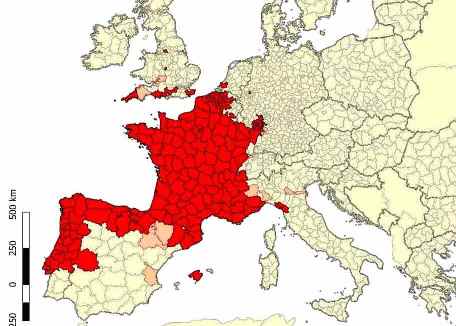
The Asian hornet is not the only dangerous alien in the EU; in total, agricultural organizations have counted 37 of the most dangerous aliens that can cause enormous damage to agriculture. Not all of them are dangerous to bees; among them are water hyacinth, red crab and others. But let's return to the Asian hornet. The Asian hornet is considered to be the most dangerous invasive species in Europe. Scientists believe that the Asian hornet has adapted to the climate of Europe and will continue to spread at a rapid pace in the future, especially since climate change favors this.
Why is the Asian hornet dangerous?
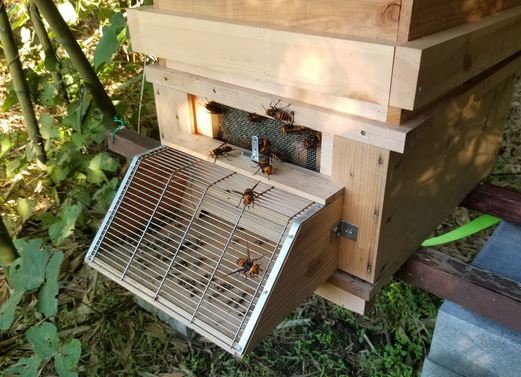
Asian hornets can hunt a wide variety of insects, from small midges to dragonflies, but if an apiary is found near an Asian hornet nest, the hornets tend to make bees their specialized prey—84% of the Asian hornet's diet is honey bees. Typically, the hornet hovers at the entrance to the hive, lies in wait for emerging worker bees and decapitates them with one movement of its jaws. He can also break into the hive to feast on honey or gnaw larvae from the cells.
In Asia, local bees are Apis serana, smaller than European bees, but they have developed a technique for fighting hornets. Asian bees closely monitor the appearance of solitary scout hornets. When they notice it, all the bees fly out of the hive and form a ball of their bodies, in this ball there are from several tens to several hundred bees, thereby raising the hornet’s body temperature to a fatal level above + 45 C. Thus, they prevent a coordinated attack to the hive.
But European bees do not have such an instinct, only Cypriot bees have something similar, the bees stick around a large eastern hornet, and deprive it of the ability to open the breathing holes located on the hornet’s abdomen, but they do not raise the temperature to lethal for the Asian hornet +45 C. other breeds of European bees do not have this instinct.
Therefore, in European apiaries, bees do not pay attention to scout hornets and only react to an attack by an Asian hornet on the hive. And the attack of the Asian hornet on a hive is carried out by an organized group of hornets, several dozen individuals, and they easily destroy all the bees that leave the hive, and then penetrate the hive and complete the destruction of the hive, taking the bee brood to their nest.
Beekeepers who have encountered hornet attacks on their apiaries state that not only beekeeping, but agriculture as a whole is suffering. The fact is that hornets not only attack and destroy bees, the matter is complicated by the fact that when they attack an apiary, the hornets destroy one hive completely, but at the same time the entire apiary stops working. The entire apiary, sensing the smell of danger pheromones from a destroyed hive, stops flying out of the hives and “prepares defense” against the next attack. As a result, honey yield can drop by 70%, and pollination stops completely. The hornets themselves leave the smell of their pheromone, which marks the apiary, and in the future the hornets will attack it constantly, until the apiary is completely destroyed, even if it is possible to destroy a certain number of their colonies. In addition to stopping pollination after exterminating wild pollinators and honey bees, the hornet causes significant direct damage to gardens - hornets spoil all sweet fruits - they gnaw plums, pears, grapes, etc. So the Asian hornet is dangerous not only for beekeepers, but also for farmers. To give you an idea, bee pollination of crops in France alone is estimated at 2 billion euros. The Asian hornet could not only cause damage to the French economy of 2 billion euros a year, but also bring it to the brink of famine. This prospect is quite realistic for the whole of Europe, given the pace at which the hornet is spreading throughout the EU countries.
In Catalonia, there has been a significant increase in the number of hornets and mass attacks on hives in 2022, with 53,000 hives destroyed. In apiaries, the death of more than 40% of the bee population and a decrease in apiary productivity by more than 30% were noted. Beekeepers noted that
This alarming situation not only affects the beekeeping sector, but also has serious consequences for public health, food production and the decline of biodiversity in Catalonia.
Measures to combat the Asian hornet
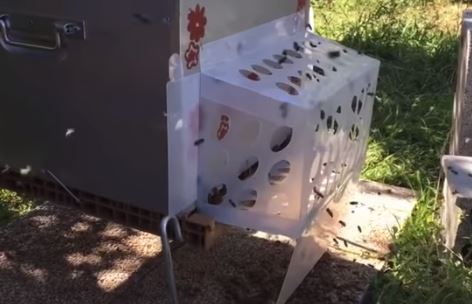
Photo This is how hives are protected from Asian hornets in Europe
No effective measures have been developed to combat Asian hornets. French beekeepers fought hornets using traditional traps, as well as shooting hornet nests with guns, but without much success.
Some control measures are dangerous not only for hornets, but also for beekeepers - when approaching the nest, the hornets fly out and attack in a swarm, both during the day and at night, and this can end sadly for the beekeeper.
The most effective way to combat the Asian hornet is the creation of special teams that specialize in destroying hornet nests. However, even they cannot destroy more than 40% of Asian hornet nests.
One of the new methods developed by Spanish beekeepers to combat the hornet is the use of drones - drones that are loaded with 4 liters of poison and sent to the hornets' nest, where they spray the poison inside the nest. This method is good because the Asian hornet’s nest is often located at a high altitude and it is difficult to reach them without a drone.
The search for effective measures to combat the Asian hornet continues.
Asian hornet in Russia
In Russia, this pest can appear either by passing through the whole of Europe, or by sailing by ship from France, Belgium, Spain, Italy, Germany, England, Portugal to one of the ports in the south of Russia. So beekeepers and veterinary services need to be careful. Considering that in Europe the Asian hornet has spread to the latitude of Hamburg, in Russia the hornet can occupy a significant territory of the European part of the country, Kazakhstan and Central Asia. In this case, beekeeping in these territories will be seriously undermined and will lose 30-50% of bee colonies annually, large losses will be caused to horticulture and viticulture, and there will be significant losses in the yield of bee-pollinated crops.
